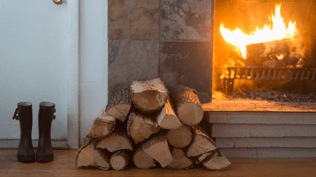 Even in our mild climate of Northern California, it still gets chilly with temperatures down into the 30’s every winter. It can be costly to run a full home heater and there are many of us who still use alternative heating sources. They can save money and allow you to keep certain parts of the house warm while saving energy.
Even in our mild climate of Northern California, it still gets chilly with temperatures down into the 30’s every winter. It can be costly to run a full home heater and there are many of us who still use alternative heating sources. They can save money and allow you to keep certain parts of the house warm while saving energy.
There are also cases when the power goes out and staying warm becomes a matter of survival. We support you choosing how to keep you and your family warm this winter, but we want you to be safe and aware with whatever heat source you select.
Carbon Monoxide Poisoning
The greatest danger when using alternative heating sources is Carbon Monoxide (CO) poisoning, sometimes referred to as the “silent killer”. CO gas is odorless and invisible which makes it difficult to detect. It can be created from small gas engines like generators, camp lanterns and stoves, furnaces, charcoal grills, and gas ranges and heaters.
CO poisoning is most likely to occur in wintertime as people are trying to use cost efficient and alternative sources to cook and keep warm. It’s very important to keep a carbon monoxide alarm in rooms where people will be sleeping. The elderly and young children are most susceptible.
Symptoms of CO poisoning include:
- Persistent headaches
- Weakness
- Dizziness
- Nausea/vomiting
- Breathing issues
- Blurred vision
- Confusion
According to the CDC, each year, more than 400 Americans die from unintentional CO poisoning not linked to fires, more than 20,000 visit the emergency room, and more than 4,000 are hospitalized. You can help keep your home safe by following best practices when using alternative heating sources.
Preventing Carbon Monoxide Poisoning When Using Alternative Heating Sources
First and foremost, it’s critical that you install a battery-operated carbon monoxide detector in your home, and replace the battery when you change your clocks in the Spring and Fall.
Some of the most common heating sources that aren’t your home’s central unit, are fireplaces, space heaters, and generator powered sources. Here are some safety tips for when you use these alternative heating sources.
Electric space heaters
- Electric space heaters should always be carefully checked before use and monitored constantly while they are in use. Even if they came with safety features such as automatic turn-offs, monitor the heater yourself to make sure it is operating safely.
- Use heaters on the floor. Never place heaters on furniture, since they may fall, dislodging or breaking parts in the heater, which could result in a fire or shock hazard.
- Keep heaters away from wet or damp places, such as bathrooms; corrosion or other damage may lead to a fire or create a shock hazard. Never use heaters to thaw pipes, or dry laundry.
- Never cover cords with rugs or carpets. Placing anything on top of the cord could cause the cord to overheat and could cause a fire.
Wood-burning stoves and heaters
- Follow all building codes and manufacturer’s instructions during installation.
- Place all stoves on an approved floor protector or fire resistant floor.
- Burn only seasoned hardwood - not trash, cardboard boxes, or Christmas trees because these items burn unevenly, may contain toxins, and increase the risk of uncontrolled fires.
- Have a professional chimney sweep inspect chimneys annually for cracks, blockages and leaks and have them cleaned and repaired as needed. Check chimney and stove pipes frequently during the heating season for creosote build-up, especially if your firewood is at all on the green side.
Kerosene heaters
- Purchase a unit featuring the Underwriters Laboratory (ul) listing.
- Choose a model with an automatic safety switch that will shut off the unit if it were tipped over accidentally.
- Look for special features such as:
- An automatic starter that will eliminate the need for matches.
- A fuel gauge to prevent overfilling the heater, causing a hazard.
- A safety grill that can prevent accidental contact burns.
Other heat sources
If you have another type of heater, such as a pellet stove, be sure to operate it according to the manufacturer's recommendations, and in accordance with all local and state installation requirements.
Read the full article and all the safety tips by clicking here
If carbon monoxide poisoning is suspected, call 911 or your local Poison Control Center or consult a health care professional right away.
Safety First
Keeping your family warm and safe this winter is a priority, and we encourage you to be prepared for emergencies like power outages. Remember that in addition to heating sources that run on energy, dressing in layers, sleeping bags, and blankets can also help when you need to stay warm.
If you’re every worried about someone in your household potentially having CO poisoning, we recommend checking with a medical professional. Our Orchard Hospital's Medical Specialty Center - Your Everyday Health Care Clinic – is ready to help when needed!



